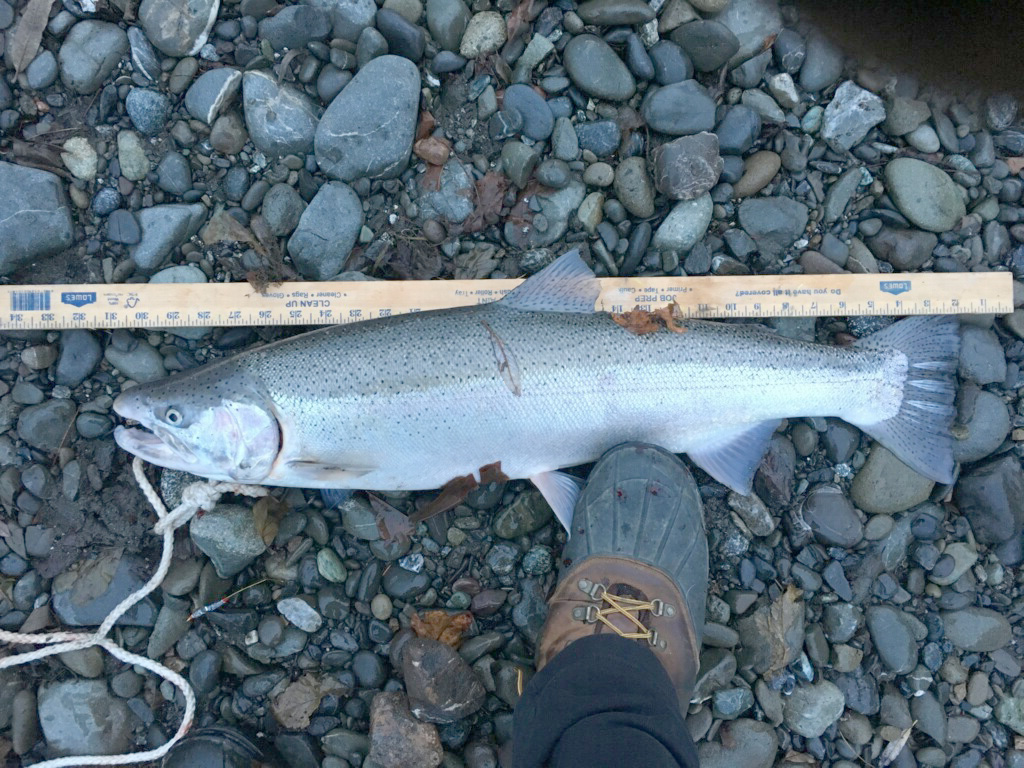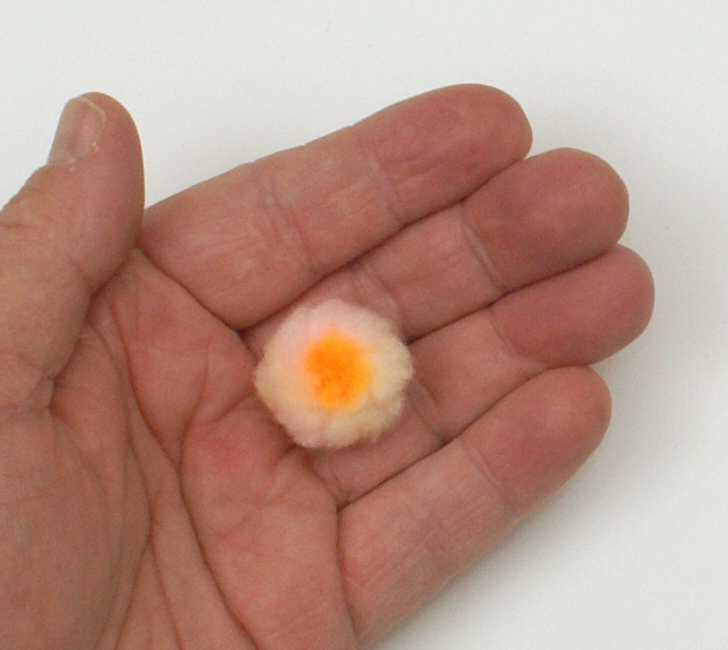Chetco River Fish Report for 12-22-2018
The Plunker's Bible
Chetco River - Brookings, OR (Curry County)

by Larry Ellis
12-22-2018
Website
They’re here, they’re finally here! I’m talking about the badly-needed rain that the southern Oregon and northern California coast has desperately needed. And it couldn’t have happened a monsoon too soon!
Heavy rains hammered the southern Oregon coast last week, and the National Weather Service has predicted that a very large blow-out will be occurring on the Chetco River this weekend and into next week.
On December 16, rain raised the Chetco’s flow to 4,490 cubic feet per second (CFS), and it was still on-the-rise on December 18, when the river was raised to 23,300 cfs. For a brief spell on December 20, the river lowered to 5,370 cfs but it was back on the rise to 9,550 cfs by early evening.
For a brief period of time on December 15, several steelhead were landed by bank fishermen who were plunking Spin-N-Glos, especially when the river was on-the-drop. But for 5 days, from December 16-20 it was totally unfishable when the river blew out big time and took on the color of chocolate milk.
And it’s not over yet!
The NWS has predicted that the Chetco will rise to over 25,000 cfs on Christmas day, the first major blow out of the Chetco.
Without a doubt, those who are plunking Spin-N-Glos from the bank will get the first crack at catching winter steelhead. And, when the river finally decides to drop and clear, the plunkers will have the whole river to themselves, the reasoning being – there won’t be any drift boat fishermen to contend with.
Drift boat fishermen just don’t launch their boats when the river is over 4,200 cfs. It’s just way to dangerous and flowing too rapidly to effectively deploy any side-drifting techniques.
So, when the river is on-the-drop, and is clearing from a muddy texture to a green-shamrock hue, the plunkers own the river.
So what is plunking exactly?
To sum it up, plunking is basically still-fishing from the bank. An angler casts a certain setup into the river, puts the fishing rod in a sturdy holder, and waits for a streamlined locomotive to hammer the lure while making its way up the tracks to its native spawning grounds.
Almost without exception, the lure that is always used is the Spin-N-Glo.
There are five colors of Spin-N-Glos that are practically guaranteed to find their way into the inside of a steelhead’s mouth, with the majority of steelhead being caught on the size 4 winged bobbers, with the number 6 running a close second.
So if you want to make your family member or friend extremely happy when the river drops after Christmas, drop one or all of these five colors in sizes 4 and 6 into their Christmas stocking. I will guarantee that their jaws will drop with pleasure.
And, it won’t upset your pocketbook either. With one of each lure color in two sizes, the price tag should be well under $20.00. If you want to add a buffer to the deal, you might think of getting two of each color just in case you break off the color of the day.
Anyway, one of these 5 colors will always get you bit.
1. Flame Chartreuse with white wings: This color has been dubbed “the Umpqua special” or “the Chetco special” (or whichever river you are on at the time), because it flat-out produces more steelhead than I have ever seen. It is colloquially also known as a “stop-and-go” or a “half-and-half."
2. My second-favorite choice would be Sherbet with black wings. I have seen an awful lot of steelhead caught on this color, especially early in the season. It has also been called Tequila Sunrise, because it has an Irish-green cap (green being the grenadine) and has an orange juice hue changing to a reddish glow for the body.
3. Anglers should always carry a color known as Egg Fluorescent with white wings. This has always been a top producer on the Chetco and neighboring Smith Rivers.
4. When you can’t get bit on any of the three previous colors, pink with white wings has always been a stalwart color.
5. And last, but not least, Pearl Pink with white wings works especially well, notably in water that is rapidly clearing. It is, in fact, my go-to color for gin-clear water conditions.
At any rate, one of the aforementioned colors is the equivalent of a steelhead waiting for an angler to happen.
So what kind of water do plunkers look for?
First of all, only deploy a plunking setup when the river is dropping, or is referred to being on-the-drop. A dropping river is a must-have situation for deploying any steelhead technique. Steelhead are just not in their top-biting form when the river is rising.
Secondly, and we’re just talking about the Chetco River, only plunk when the river is below 10,000 cfs. Between 4,000 and 7,000 cfs, and a dropping river are ideal water conditions.
Third, look for riverbanks that have steeper sides than usual. This often happens after a major blowout. Which brings me to the next tip.
Fourth, cast close to the bank. Steelhead won’t be traveling up the middle, faster-moving portions of the river. They’ll be making their way up the slower water going up the side of the river. The biggest mistake that plunkers make is casting out too far.
However, there are exceptions to this rule. If the river is shallow and extends out 20 feet or more, then, by all means, make your cast to the end of this current break. Otherwise, if the bank is steep, you can often catch steelhead within 6 feet from the bank.
Fifth, look for current seams. When the river is high, current seams will often run closer to the bank. Current seams are visible places where the calm water close to shore meets the faster water further out.
Calm water will basically appear flat on the surface, while fast water will have a ripple on top. Cast to all portions of these current seams, because you never know where a steelhead’s migration pattern is going to be on any given day.
Sixth, hammer a sturdy rod holder into the riverbed, put your rod in its holder, and wait for the rod to double over. Often, people will put bells on their rods to signal that a bite is occurring. Anglers will also set their drags slightly loose and then put the reels in clicker mode. But, I prefer the bells because you can audibly hear everything that happens to a rod.
A lot of people will also add a little bit of roe in their egg loops for scent, but the fact is, you don’t have to use roe at all in order to get bit.
There are several ways of rigging up for plunking. No matter which setup you choose to use, make sure to load your reel with 25-pound monofilament mainline. Some folks prefer to use braid for their mainline, but I prefer mono because it comes off the reel very smoothly when a steelhead makes a run.
Smoother runs mean that your hook will have less of a chance of working loose from the steelhead’s mouth.
I will then run my mainline through a slider, which can be bought for a nominal fee, usually under a buck.
After running your mainline though the slider, slide it through a 6mm bead before tying it off to a number 5 barrel swivel.
You will need to make a leader between 18- and 30-inches long, and tie it off to a Gamakatsu 1/0 octopus hook using an egg loop knot. The monofilament leader can range from 12- to 15-pound test.
Now slide a 5 or 6 mm bead down your leader onto the hook to act as a bearing against the rapidly-spinning winged bobber. Slide down the Spin-N-Glo of your choice, tie the beginning of the leader to the other end of your number 5 barrel swivel and cast to the current seam of your choice.
If your local sporting goods store is out of the color of the day, you can purchase Spin-N-Glos directly from the manufacturer at yakimabait.com.
Plunking is a social activity. It is not uncommon for a group of plunkers to gather around a fire and exchange far fetched fables about the big one that got away.
Tight lines!
Larry Ellis, author, writer, columnist and photographer has had a 50-year passion for fishing in California and Oregon's saltwater and freshwater venues. He is a well-known writer for Oregon, Washington and California Fishing and Hunting News, Northwest Sportsman, California Sportsman and Pacific Coast Sportfishing. He currently writes monthly for Salmon Trout Steelheader Magazine, and is the author of two books, "Plug Fishing for Salmon" and "Buoy 10, the World's Largest Salmon Run." Both books can be bought from Amato Publications (amatobooks.com), Amazon and eBay. Ellis particularly loves living in his hometown of Brookings, Oregon - The heart of salmon country and gateway to fishing paradise.
More Reports
Drift-Fish Your Way into a Steelhead's Mouth
Chetco River
12-15-2018
It’s almost time to catch your first steelhead of the winter season, and if you’re a bank fisherman, drift-fishing is...... Read More
Make Your Own Steelhead Yarn Balls
Chetco River
12-10-2018
Friday, December 21 marks the beginning of winter, and with a little bit of luck, the first big storm coinciding...... Read More

Website Hosting and Design provided by TECK.net